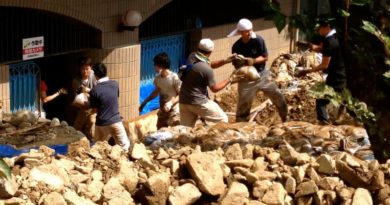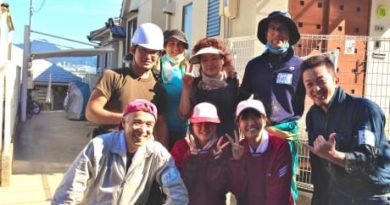Hiroshima Landslide Volunteering 5-Point Guide
It’s wonderful that so many people are interested in volunteering to help local communities pick-up the pieces to rebuild their lives after the devastation of 7/7/2018. There is a wonderful ‘Volunteer Handbook’ in Japanese given to all volunteers, and I am working on an English version to help international volunteers who may not have the language skills or cultural knowledge to pick up on many of the useful recommendations. Until the longer guide is finished, I hope this 5-point guide can be useful to anyone hoping to volunteer.
First time volunteers should have a look at this English Volunteering Handbook. Or see a list of the pages of the English Handbook for Landslide Disaster Volunteering here on Inbound Ambassador.
#1 – Get Insurance – it costs 350 yen (or 510 for a bit more coverage) to get volunteer coverage for the year and really is a must before volunteering. This insurance not only protects you in case you get injured but also cover you in any event of others around you being injured or accidental damage of other people’s property. You can sign up quickly and easily as long as you have a Japan-based address (write it in English letters (Romaji) is fine. Some volunteer sign-in areas at communities have insurance at the sign-in desk (uketsuke), but others do not.
GOOD NEWS: it is NO PROBLEM for anyone to get insurance (expats, visitors, all are welcome!). If you are visiting, please use the address of a hotel or guest house to sign up. They will give you a form in Japanese with all the details of the insurance coverage, please use google translate (or another app) to clearly understand the contents of the coverage.
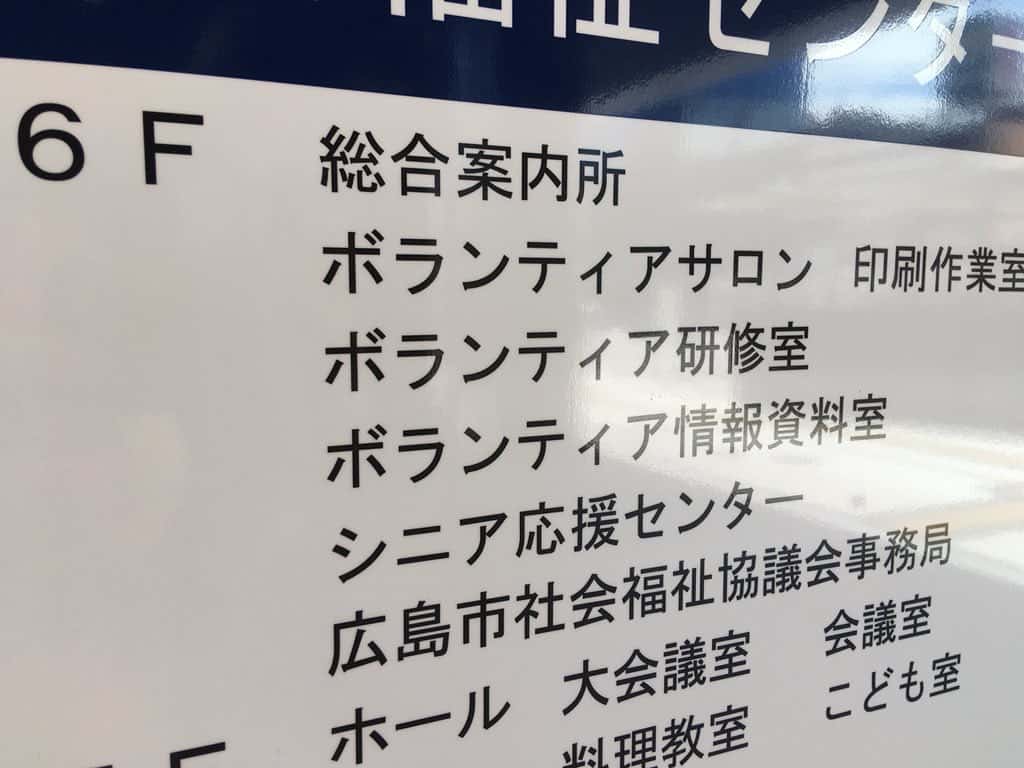
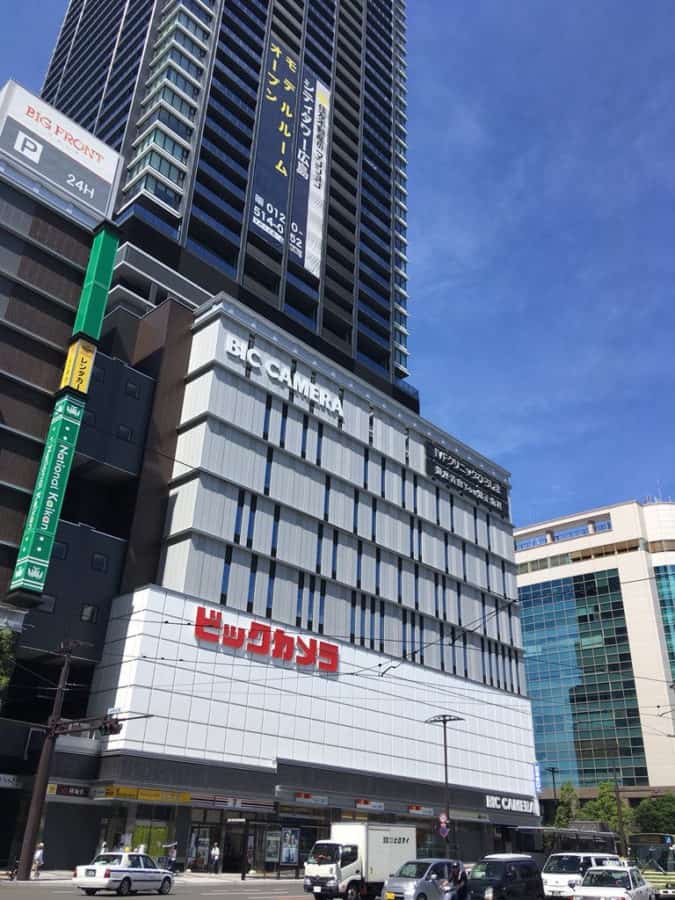

The easiest place to get insurance for volunteering is to go to the building opposite Hiroshima station’s main exit. This Bic Camera / BIG FRONT building on the 6th floor. There is a big office on the right as you exit the elevator. Go to the main desk where you can sign up quickly and easily. Use the photos above as a reference guide to help you find it and to see what your insurance card should look like.
You will be asked to write your name, address, telephone number and age. The card they give you should be shown at any volunteer registration whenever, or wherever, you volunteer. It should be good for volunteering activities anywhere in Japan.
#2 – Dress appropriately: Although you will see people volunteering in shorts and slippers, you’ll be much more comfortable if you wear long (light) sleeves (swim rashguards work well), long trousers, rubber boots or work boots, a hat or helmet, sunglasses, a sport (face) towel around your neck (to wipe sweat or grime off your face) and long socks if you can bear it. This protects you not only from the mud and scratches from debris, but also protects from the sun and insect bites. You can see my first volunteer crew in 2014 below (HIS principal Mark Exton, Local Doctor Yasu Ikegami and me) to get an idea of how you may look at the end of a shift (happy but tired and in need of a shower).
Most jobs involve moving or digging out dirt (or mud), so you will likely be covered in dust and mud soon which makes you look much cooler 😉 . I wouldn’t recommend wearing any of your favorite clothes as they might be damaged or stained. 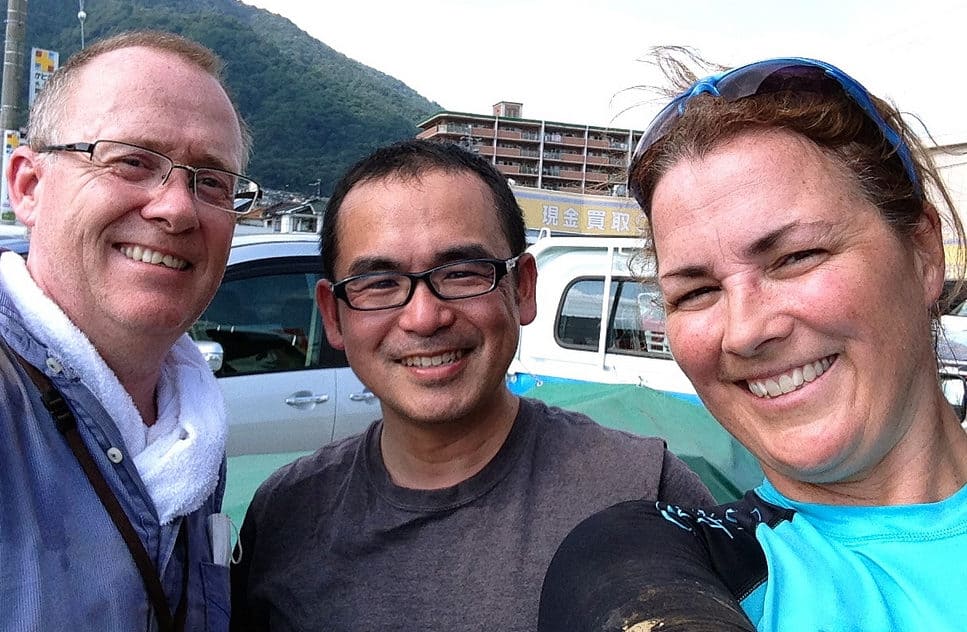

#3 – Groupism: In many cases, you will be asked to work with a group and a leader will be assigned (usually someone who has experience in the area or at least in landslide volunteering). The leader will make a short speech giving information on the area and once on location will show you the jobs to do. The leader should also know and tell the group where the nearest toilet is to use (usually inside a neighboring house). It’s best to follow what the others do (take off shoes if they do to go in a house, stand around to listen to someone if they do, take a break if everyone does, bow to locals like they do..). Probably best if you don’t start off cleaning up anywhere on your own or start before the others, but do make sure to take breaks whenever you need to. When talking with people (especially for the first time) probably best to take off hat and sunglasses to be polite.
#4 – Be Sensitive to Locals: The guidebook warns volunteers not to take pictures (without permission) and to be cheerful and polite when talking with local people in affected areas. It also warns not to say ‘Ganbatte’ (You can do it! / Go for it!) as the local people are already working too hard and may feel pushed to work even harder to help recovery. It may be better to concentrate on eye-contact, bowing, smiling and saying “arigato” (thank you) whenever people are kind to you or help you do something (happens quite often).
#5 – Be Sensitive to Yourself: It is likely that being around landslide devastation will take an emotional toll on you even after the physical challenges of volunteering, such as stiff muscles, disappear. The guidebook warns of possible depression or feeling overwhelmed after volunteer activity. As long as you know to expect it, this should be easier to handle. Try to give yourself time off after volunteering to relax and recover and talk with friends or family about your experience.
There is a lot more in the volunteer handbook, but the above should be enough to get you started. If you are keen to volunteer, please do so! It is a wonderful feeling to be able to help in even a small way when a disaster like this strikes our community. Whenever I volunteer I’m reminded that natural disasters seem to strike at random, there is no one to blame, only bad luck and if I am lucky enough not to lose my loved ones and property, I am happy to try to help those who have suffered loss. I would be so grateful for help if it happened to me. You will find a great community spirit while volunteering in Japan which I hope you can find inspiring in overcoming your own personal challenges. The strength of character and resilience of Hiroshima people to overcome disaster and move on positively is so admirable.
First time volunteers should have a look at this English Volunteering Handbook. Or see a list of the pages of the English Handbook for Landslide Disaster Volunteering here on Inbound Ambassador.
7/19 Update: Locations in Hiroshima accepting volunteers from outside
- The Island of Ninoshima is accepting sign-ups between 8am-9am and you should be able to ride the ferry across to the island for free (from Ujina Port) if you say “volunteer” to the staff at the ticket office or to the boat crew when you board. You can go to Ujina port from Hiroshima station by street-car/tram in about 30 minutes/ by bus in about 20 minutes. According to the facebook page, they are accepting 100 volunteers each day (from outside the area is ok). (Most places are only accepting 50). Volunteering will stop each day at 12noon due to the extreme heatwave. See more details in Japanese on the NINOSHIMA Disaster Volunteer Facebook page.
- Volunteering at Kuchita (Asa-Kita-Ku) – Reception open- 8:30am-5pm – Free parking at Kuchita Elementary lot next to Volunteer tent. Short time volunteering is no problem. All are welcome. Insurance covered by local area for all volunteers for 1 month. Bus from Hiroshima station in about 30 minutes & 20 minute walk to volunteer station.
- Volunteering at Koda/Yoshida (Akitakata-shi) by reservation only – please call. There is a possibility of a place to stay for volunteers willing to work more than 1 day (90 min bus to get there from Sogo Bus Center). Please call by at least the day before to check on need: Call to sign up with the coordinator in English is OK (Kaz Meiki) 090-1390-3534 /More information and updates on the Facebook page (Japanese)



